How to Upload Code Into Arduino Lilypad via Ftdi
Introduction
In this tutorial, nosotros'll testify y'all how to install FTDI drivers on multiple operating systems. Although this tutorial was written using Windows 7, Mac Os 10 10.vi, and Ubuntu 13.04, the process should be very similar, if not exactly the same, for other versions/variations of these operating systems.
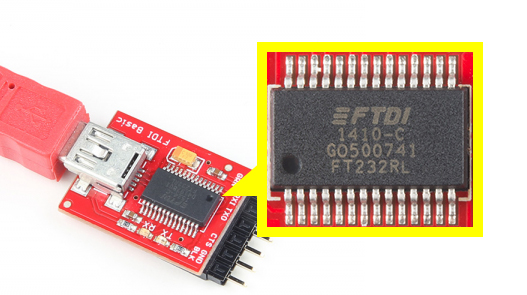
Suggested Reading
Before you begin this tutorial, you lot should take the Arduino IDE installed on your estimator. Check out our Installing Arduino tutorial for a step by step guide.
Hither are some other tutorials and concepts you may want to familiarize yourself with before reading this tutorial:
- What is an Arduino?
- Serial Communication
- RS-232 vs TTL Serial Advice
- Logic Levels
- Connector Basics
Alright, let's get to work! Yous tin visit the adjacent section to acquire more than near the FTDI Basic and why you demand the FTDI drivers, or you tin skip straight to the operating system of your choice!
Meet the FT232RL
The FT232RL is 1 of the more than commonly used ICs used to convert USB signals to UART signals. This process is very handy in that it allows y'all communicate with and upload code to an Arduino or other microcontroller without the need for an external programmer. SparkFun carries a board chosen the FTDI Bones that conveniently breaks out the necessary pins on the FT232RL to perform these deportment.

SparkFun'due south 5V FTDI Basic. Notice the IC--FT232RL.
There are a few different flavors of the FTDI Basic:
MIKROE FTDI Click
DEV-18945
MIKROE FTDI Click features FT2232H - dual high speed USB two.0 to UART/I2C/SPI serial interface converter.
If you are using a 5 volt device, you will need the 5 volt FTDI. If you accept a 3.3 volt device, you guessed it, use a 3.3 volt FTDI. LilyPad boards all operate on 3.3V.
We also conduct a consummate breakout board for the FT232RL should you need access to more pins than the FTDI Bones provides.
Here is a list of some SparkFun products that require the use of an FTDI Bones, come with an FTDI Basic, or have an FT232RL chip on board:
- RedBoard
- Arduino Pro 5V and 3.3V
- Arduino Pro Mini 5V and 3.3V
- Mega Pro 5V and 3.3V
- Mega Pro Mini
- LilyPad Main Lath
- LilyPad Simple Board
- Arduino FIO
- Protosnap - Pro Mini
- Protosnap - LilyPad Development Board
- Protosnap - LilyPad Development Board Simple
There are also some legacy Arduino boards that use the FT232RL. The Arduino Diecimila and Duemilanove principal boards along with the original Arduino Mega all use the FT232RL IC. If you take i of these older versions, you'll want to use the FDTI drivers as well. For a complete list of all Arduino boards, check out this page. Newer versions of Arduino boards, such equally the Uno, use a different communication IC, and they will non be covered in this tutorial.
Now that yous know why the FTDI Basic is important and what products it is used for, let's larn how to install the drivers.
Windows - Quick and Piece of cake
Note: The screen shots in this tutorial are from Windows 7. The process should be very similar for other versions of Windows. For nearly tardily versions of windows, such as 8.one through Windows 10, the hardware may work fine without any commuter install. If y'all can't locate a COM port for your hardware, so the ready of instructions below is the possible fix. The exception to this is Windows 8. For instructions on how to disable device driver signatures, [delight visit this tutorial](https://learn.sparkfun.com/tutorials/disabling-driver-signature-on-windows-eight).
Note for Educators: Y'all will near likely demand to obtain administrative privileges from your network or Information technology administrator in order to install these drivers.
-
By default, windows does not have FTDI drivers installed. If you plug in your FTDI, open the Arduino IDE, get to 'Tools -> Serial Ports', and see nothing, you need the drivers! Let's go become them!
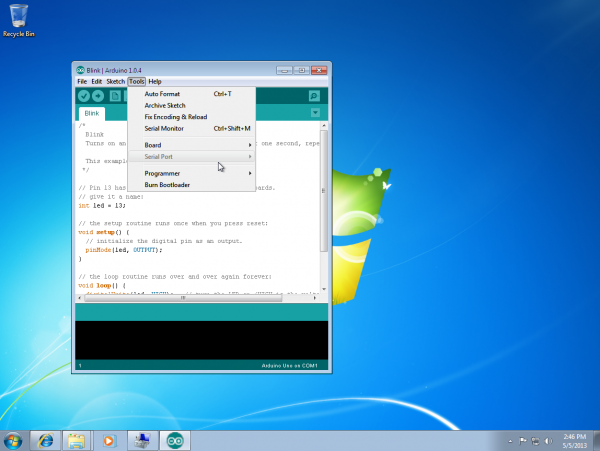
-
Download a copy of the v2.12.28 FTDI VCP Driver Executable hither:
Windows FTDI VCP Driver Executable - v2.12.28 (CDM21228_Setup.exe) Otherwise, visit FTDI's VCP Drivers page for the latest download of the Windows FTDI Driver executable and clicking on the Window's "Available as a setup executable" link. Make sure to unzip the executable earlier proceeding to the next step.
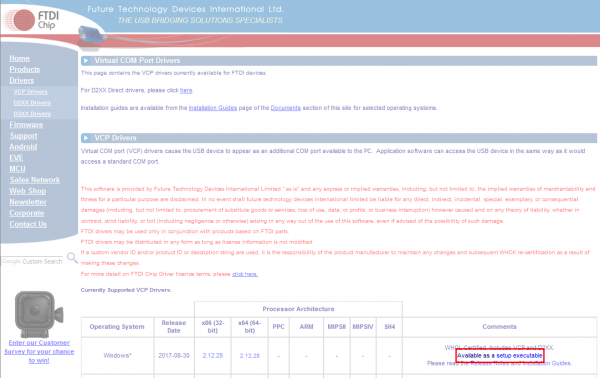
-
Choose 'Run' once it is has finished downloading, or find the file you just downloaded "CDM21228_Setup.exe" and double-click it to run it.
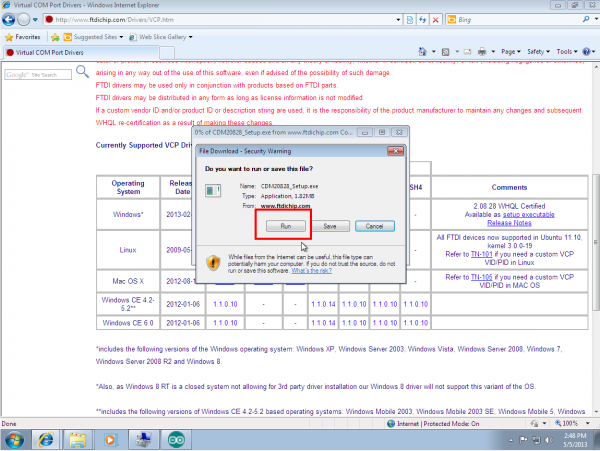
Note: At the time of this tutorial, the images were referencing the old "v2.12.00" FTDI VCP driver executable. The installation process will be the same regardless of the version number.
-
Choose 'Excerpt' and continue through the installation until it finishes.
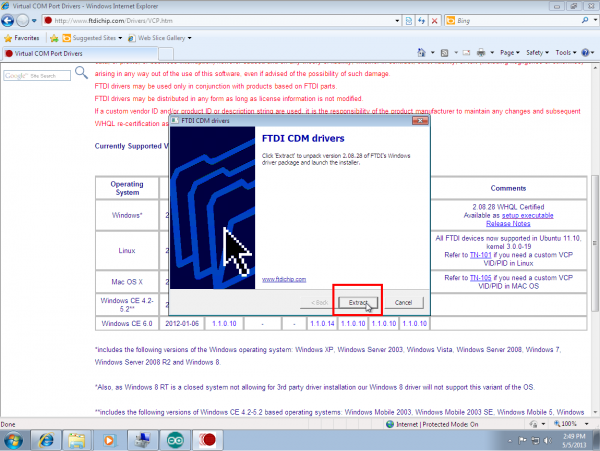
-
If everything was successful, you lot should see some nice green cheque marks, indicating success!

Note: You may need administrator privileges on your machine in guild for this to run properly. If things didn't work out, try the next section of this tutorial: Windows - In Depth.
-
Open up upward the Arduino IDE, and go to 'Tools -> Serial Port'. If you now have a COM port, congratulations! Again, if something went wrong, either retry this tutorial or give Windows - In Depth a try!
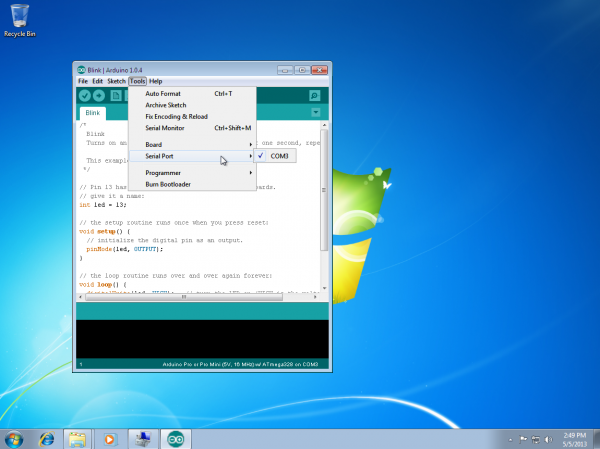
Windows - In Depth
Note: The screen shots in this tutorial are from Windows seven. The process should be very like for other versions of Windows.
Note for Educators: You will nigh likely need to obtain administrative privileges from your network or Information technology administrator in order to install these drivers.
-
Plug in your FTDI using a USB cablevision. Windows doesn't have the right drivers, so allow's notice them!

-
Navigate to the FTDI website, and choose the 'VCP' (Virtual Com Port) pick most the bottom.
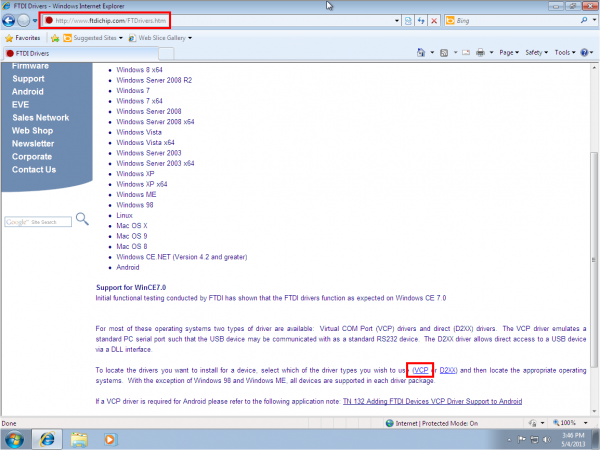
-
Now choose either the 32 flake version or the 64 scrap version. Not sure which you accept? The next steps will go over how to discover that information. If you already know which version yous are running, you may skip the next 2 steps.
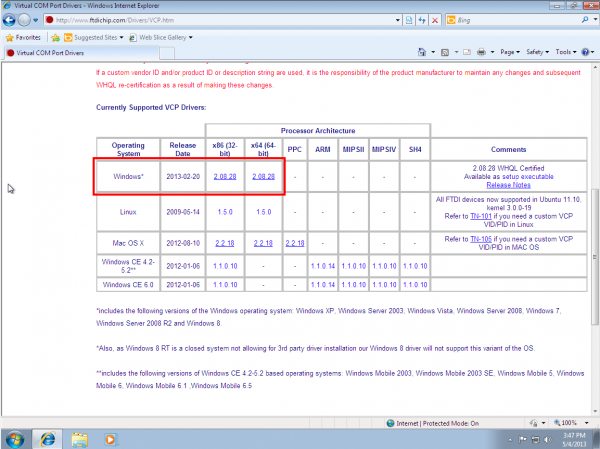
-
Open up the start menu, correct-click on 'Calculator,' and left-click on 'Properties'.

-
Await under 'System type,' to see which version yous have.

-
At present go back to the FTDI site, right-click on the correct version, and relieve it to your computer. Retrieve where the files are saved. Nosotros'll need them in the next step.

-
Navigate to the binder containing the files. They will be within of a .zip file, and then you'll demand to extract them. Right-Click on the .zip file, and choose 'Excerpt All...' When the next window appears, equally shown to a higher place, pay attention to where it is extracting the files. Make certain that 'Show extracted files when complete' is checked, and click 'Extract'.
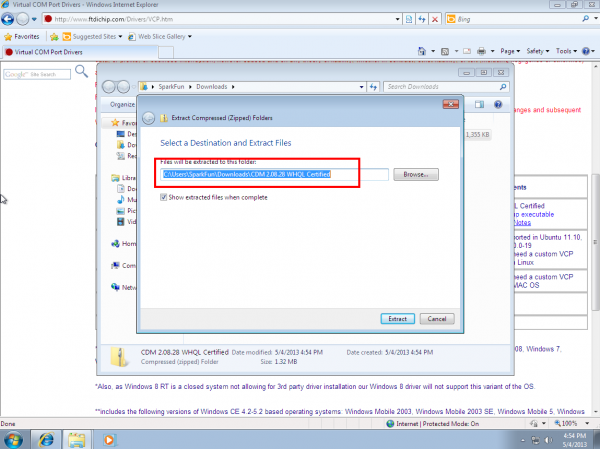
-
When the extraction is complete, the folder is opened. Over again, take note of this folder location. This is the one containing the drivers.
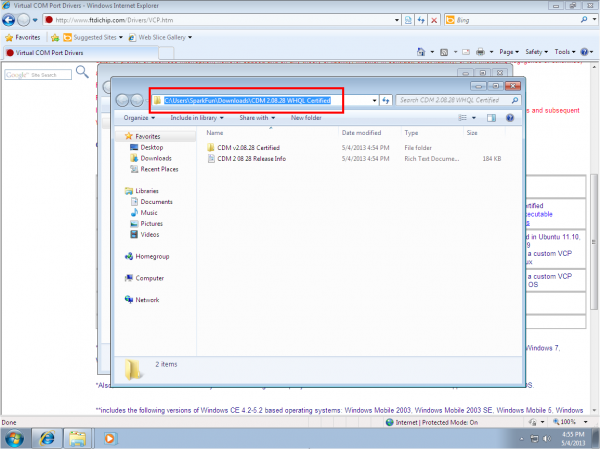
-
We're most there! Open the start menu, right-click on 'Estimator', and left-click on 'Manage'. You will need ambassador rights to practice this. If you aren't an administrator on your figurer, talk to the person who is and have them enter their credentials.

-
Left-click on 'Device Manager' in the leftmost column. Here is where we see the offending hardware. It has an exclamation mark next to it.
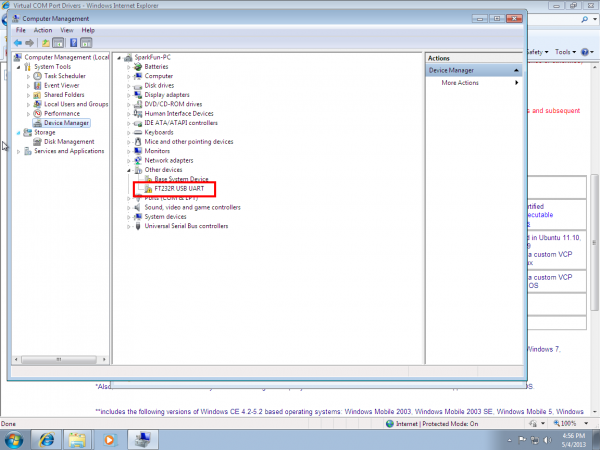
-
Right-click on 'FT232R USB UART,' and left-click 'Update Commuter Software...'
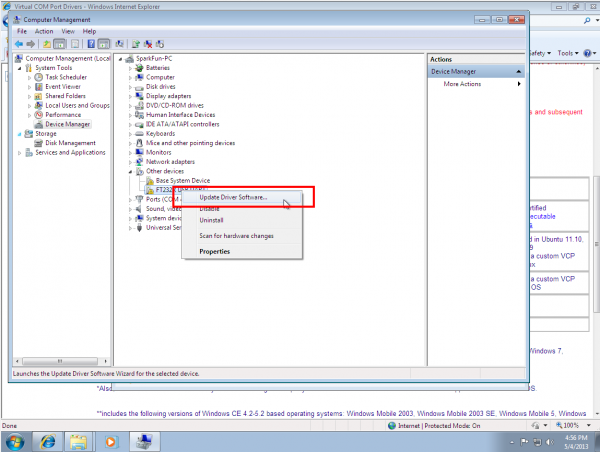
-
Now cull 'Browse my computer for driver software'.
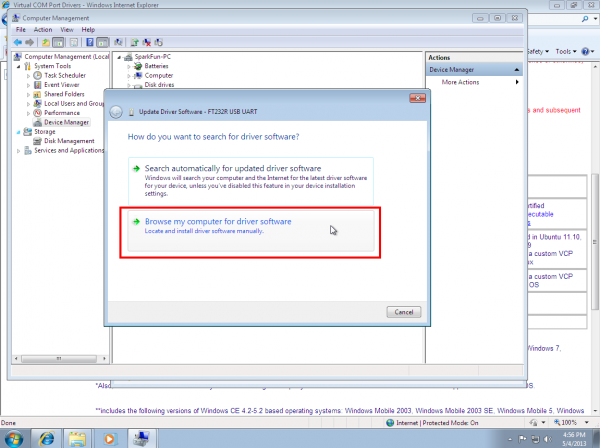
-
Left-click 'Browse,' and navigate to the location of the extracted files. Cull the extracted folder. In that location is no need to search any further in the folder. And then left-click 'OK'.

-
Make certain 'Include subfolders' is checked (very important!), and left-click 'Next'.
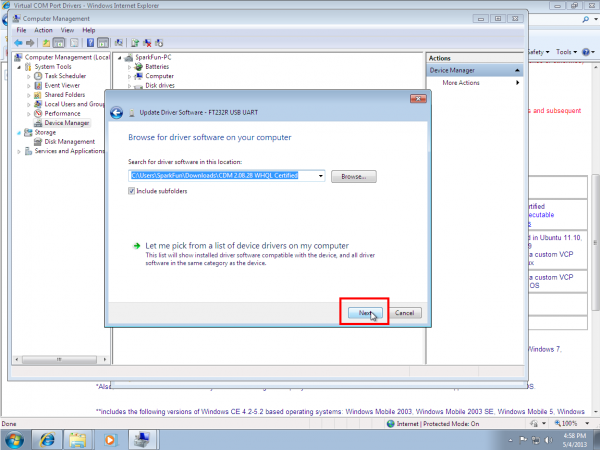
-
After a moment, you will see a success bulletin! Left-click 'Shut'.
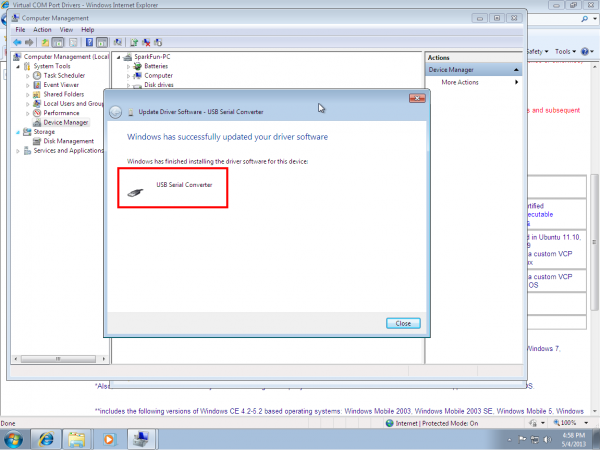
-
The Device Manager page will refresh and you volition run across a new particular with an exclamation marking named 'USB Serial Port'. You will need to install a 2nd driver for the aforementioned device. Follow the steps ane-15, every bit before, and use the same driver binder too!
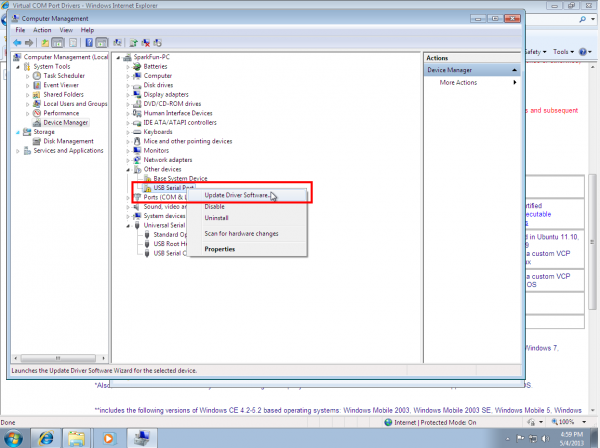
-
Once those steps are complete, you will see another success bulletin! Left-click 'Close'.
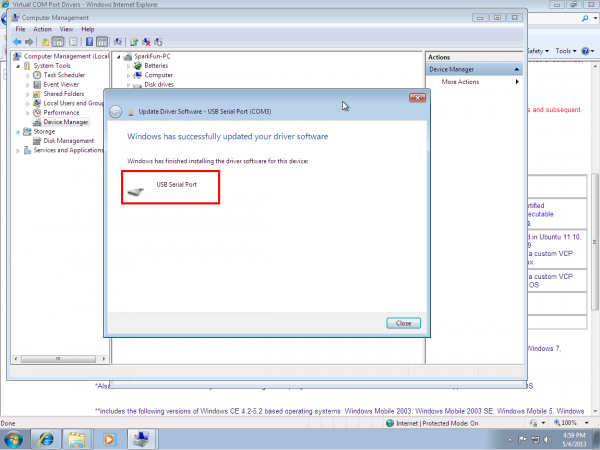
-
The Device Managing director Page will refresh again and prove 'USB Serial Port (COMxx),' where 20 = some number. Congratulations, you lot now have the proper FTDI drivers and can begin to use your device!
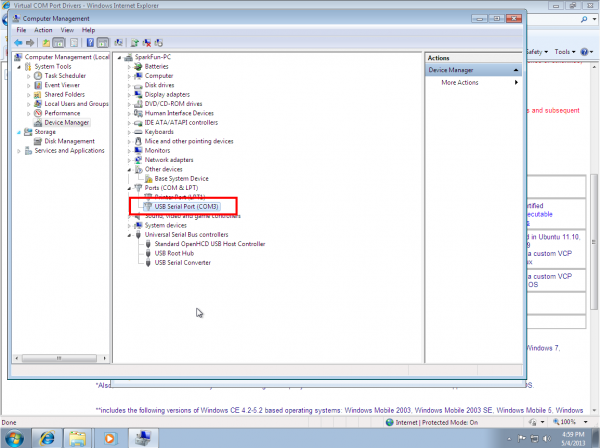
Mac
Observe: The screen shots in this tutorial are from Bone 10 ten.6. The process should exist very like, if not exactly the aforementioned, for other versions of Mac Os Ten. If you are on Os X 10.ten Yosemite, follow forth to install the drivers. If you demand to install drivers on Yosemite, please visit the bottom of this section. About people will exist using the VCP drivers and not the D2XX drivers.
Annotation for Educators: Y'all will well-nigh probable need to obtain administrative privileges from your network or IT ambassador in society to install these drivers.
-
Nigh of the time, when yous install Arduino on Mac Os Ten, the drivers are installed automatically. Yet, if there was a trouble with the installation and you don't come across any options that include 'usbserial' under the 'Tools -> Serial Port' carte, so you volition need to install the drivers. You may also need to install the total FTDI drivers if yous are running OSX 10.10 or later. The mill drivers are non complete.
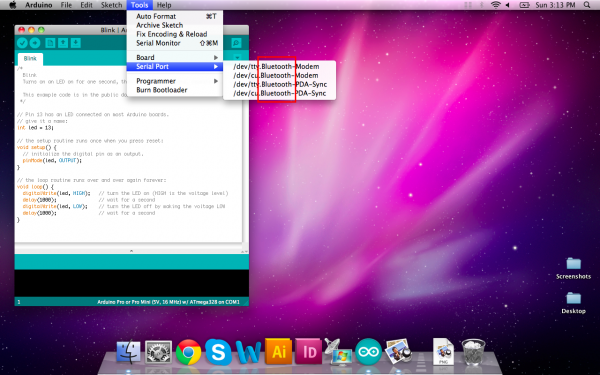
-
a.) Os Ten 10.9 (Mavericks) or above: Download this driver. Locate the file FTDIUSBSerialDriver_v2_4.two.dmg file that was downloaded to your computer, and double click on it to open \ run it.
You may need to visit FTDI'south VCP Drivers page for the latest download of the Mac OS 10 FTDI Driver. Click on the link for the "Mac OS X 10.9 and in a higher place" commuter's version. The image beneath shows version ii.4.2 then you would need to click on **two.iv.2* to download the latest driver. If there is an update to the drivers past FTDI, the version number will change but it should be in the same location on the table.
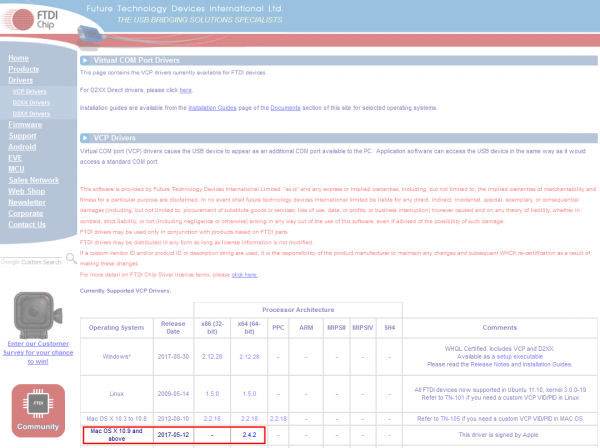
b.) OS X x.8 (Mountain King of beasts) or lower: Download this driver. Locate the file FTDIUSBSerialDriver_v2_2_18.dmg file that was downloaded to your calculator, and double click on information technology to open \ run it.
If yous are using the driver for OS X x.8 (Mountain Lion) or older, y'all will run into ii files. Open the driver file that corresponds with your operating system. For nearly users, it will exist the second file:

-
Go along through the installation, and look for it to finish. Then click 'Close.'
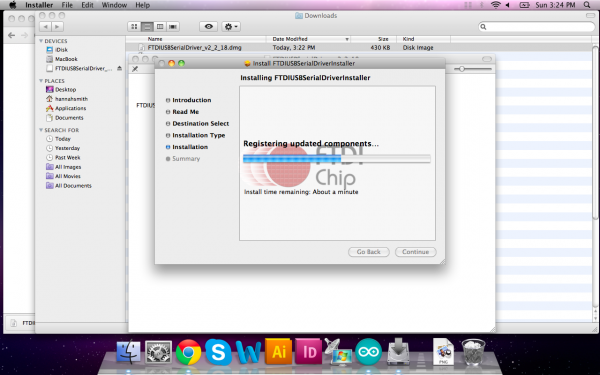
-
Now open up the Arduino IDE. Under 'Tools -> Serial Port' y'all volition now see a 'usbserial' option. Congratulations, you're all set!
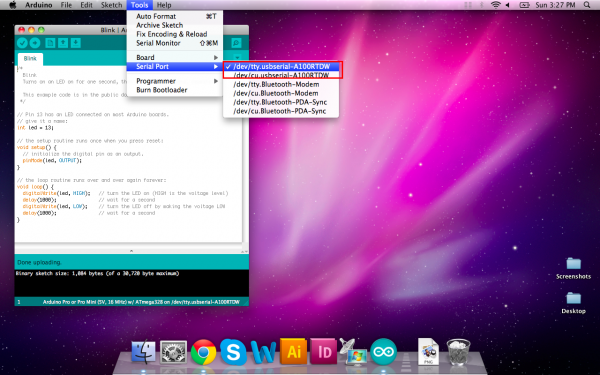
Troubleshooting: Unidentified Developer Error
On newer versions of OS X, when you double-click the install packages within the FTDI disk image, you may exist presented with a very Windows-esque type error about non being able to open up the files because they are not from an identified developers. This is very similar to the unsigned driver upshot in Windows 8.

Quick Fix
To get effectually this, merely right-click the package you want to install, or press CTRL + click, if you don't have a right-click. Then select open from the carte.
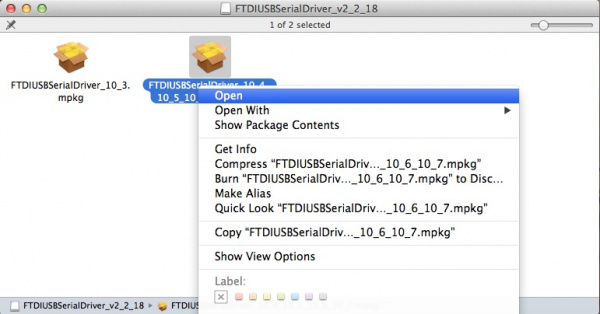
You will so be given some other window asking if you are sure. Click Open, and continue with the installation every bit stated above.
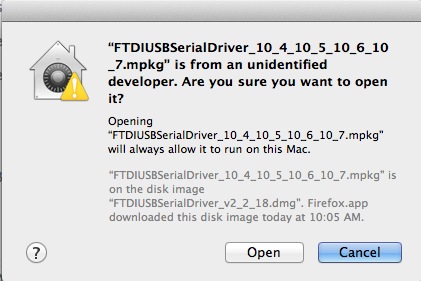
In-Depth Fix
For a more permanent fix, you can follow these instructions. **All the same, this method is non suggested as information technology leaves your computer vulnerable. **
Open your System Preferences.

Once open, click the Security & Privacy icon.

Under the General tab, yous should come across a section nearly allowing the running of downloaded applications from specific sources. In preveious version of OS X, the default was set to Anywhere. However, the defualt setting is now Mac App Store and identified developers.
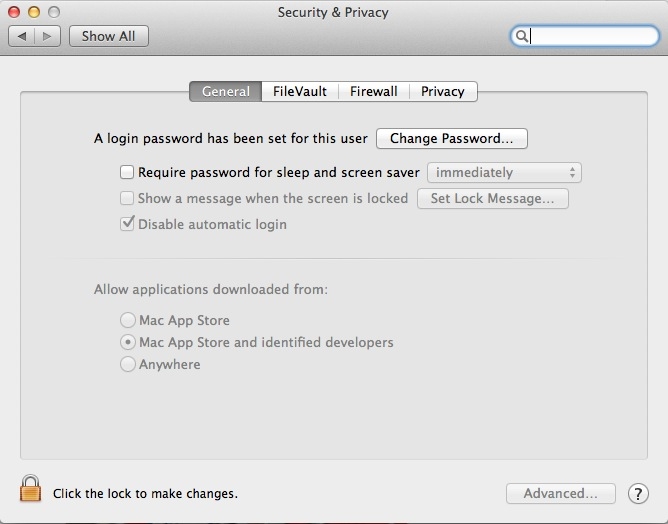
To use the FTDI drivers, you'll need to prepare this back to Anywhere. Start, you may need to click on the niggling lock icon and enter your admin countersign to make these changes.
In one case unlocked, click the Anywhere pick. Some other obnoxious window may appear request you if you're sure y'all want to allow this. Click Permit from Anywhere. Or, you tin can follow the directions in this window, if you don't want to make your Mac "less secure."
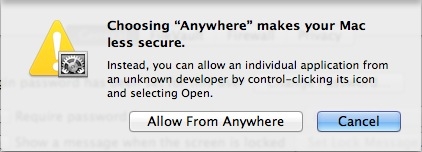
You should now be able to install the FTDI drivers.

Troubleshooting: FTDI Drivers and OS X Yosemite
With Mac OS 10.9 (Mavericks) and later, Apple has congenital their ain version of the FTDI VCP commuter into the operating system (AN134). Notwithstanding, there seems to be some disharmonize between drivers from FTDIchip.com and the ones inherent to Apple tree. Luckily, there is a solution to this trouble, and it comes from FTDI directly.
Quick Fix
If you are trying to use the FTDI VCP Commuter in your applications, it will not piece of work due to a disharmonize betwixt the VCP and D2XX drivers. In guild to become around this, the Apple supplied Driver must exist uninstalled. Plug in the FTDI device in question, and type the following command in a Concluding window:
sudo kextunload –b com.apple tree.driver.AppleUSBFTDI <ret> In-Depth Set
If the higher up doesn't work, you lot may have amend luck using this script from FTDI.
Clicking on this file volition bring upwards the Script Editor on all Macs. The script can be run by clicking on the run icon (black triangle). Again, brand sure your FTDI device is connected.
You can make this script into a clickable icon by exporting the script as an application. In the Script Editor, select Export… from the File pull down bill of fare:

In the Export dialog, select Application every bit the File Format. You can cull any proper noun for the application.
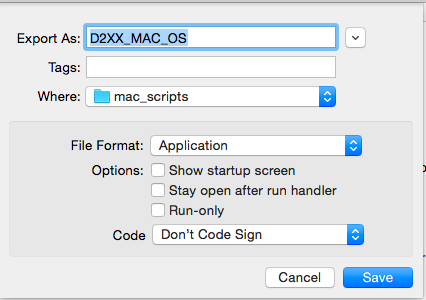
Yous should now take an automatic Apple Script icon to use on your Mac. With the Apple supplied Drivers uninstalled, you may return to the top of this section and install the FTDI VCP Driver as needed. Echo this procedure for whatsoever other FTDI devices you are using. Y'all may need to repeat this every time you restart your computer.
Troubleshooting: No FTDI Driver Installed
If you receive this error, it means that the driver has been uninstalled already, and you will need to install the FTDI VCP Driver, as stated higher up.
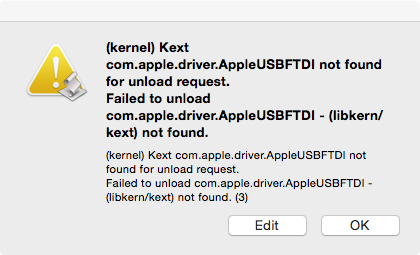
Linux
Note: The screen shot in this tutorial is from Ubuntu 13.04. The process should be very like, if not exactly the same, for other versions/variations of this operating organisation.
Annotation: You lot will most probable need to obtain administrative privileges from your network or IT ambassador in gild to install these drivers.
-
Plug in the FTDI device to a USB cablevision.
-
When you download the Arduino IDE in Linux, the download comes with the FTDI drivers arranged with the IDE. However, if you simply open Arduino from the desktop, you lot'll detect that, if you lot click on 'Tools', the 'Serial Port' option is grayed out.

-
Linux includes the drivers necessary to apply Arduino, and no additional install is needed. All the same, permissions might need to be configured. For current instructions on how to set up these permissions, visit this folio.
An culling method is to run Arduino equally root in the concluding with the post-obit command:
sudo arduinoHowever, this method is encouraged only if you know what y'all are doing and should only be used as a last resort. You volition as well need to enter your administrative password to run every bit root.
-
Arduino should open up, and this time the 'Serial Port' bill of fare is available.
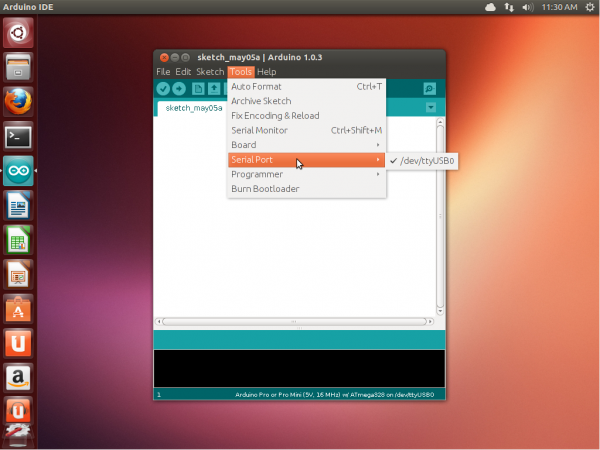
-
The FTDI device will prove up under this menu. It should be named /dev/ttyUSB0. The number may vary depending on how many USB devices you lot take plugged into your estimator. That's all.
Resources and Going Further
Now that y'all've successfully got your FTDI up and running, it'south time to comprise information technology into your own project!
For more hardware specifications, check out the resource below:
For more than information about the drivers, check out the resources beneath:
- In-depth FTDI Installation Guides - In-depth guides to install an FTDI for any OS.
- Latest FTDI Virtual COM PORT (VCP) Drivers - The latest VCP Drivers found on FTDI's website.
- SparkFun's USB Serial Commuter Quick Install Tutorial - A condensed version of our "How to Install FTDI Drivers" tutorial.
Check out these tutorials to swoop even deeper into the world of microcontrollers!
- Installing an Arduino Library - How practice I install a custom Arduino library? Information technology's piece of cake!
- Learn how to use a breadboard to interface your Arduino with circuits congenital by you.
- Learn the basics of e-textiles with this great tutorial
Or bank check out this blog mail service for more than ideas.
macdermottpubset48.blogspot.com
Source: https://learn.sparkfun.com/tutorials/how-to-install-ftdi-drivers/all